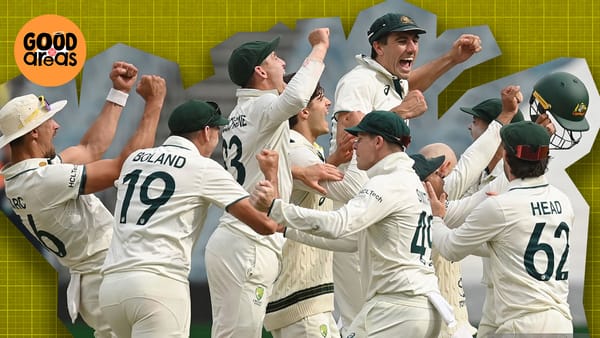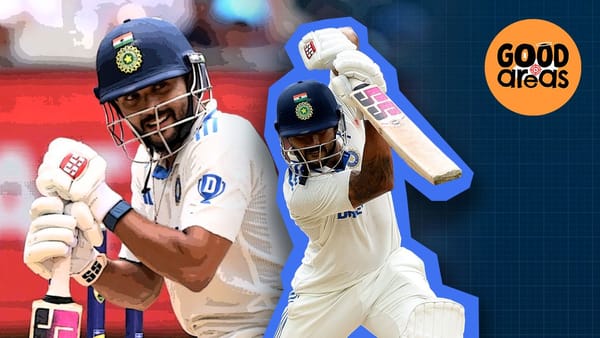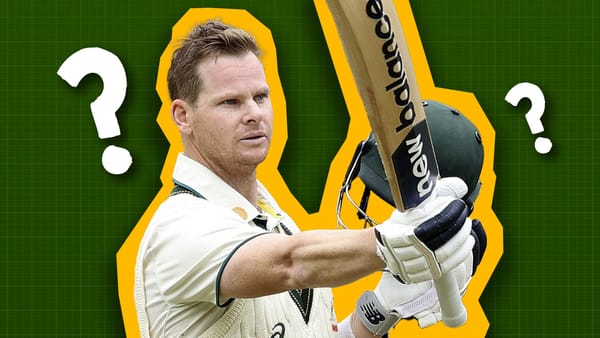Jimmy Anderson and the 2nd innings blip
No bowler has run in more, but is that why he can't get a second innings wicket.
Jimmy Anderson has been struggling in the second innings.
The presumption is that he's old. And he is old, for a pro athlete, let alone a bowler.
There is even a persistent rumour that he's about to retire. It's not the first time. A quick google search found me retirement pieces from 2017, 19, 20 and this year. Anderson is always near retirement, it seems.

But this time there are numbers as well. With people throwing out Anderson's bad second innings record of recent times. Over 100 average since the start of 2020, or for a better look, I went back to November 2018, where it's still a terrible 48. And the idea of this ofcourse is that Anderson is old, and therefore bad in the second innings. But it made me think about another period in Anderson's career where signs started pointing to his age catching up to him.

There was a major one during the mega Ashes of 2013/14. Anderson was heroic in the first Test of the 13 ashes. But no one really cared about it because Ashton Agar made 98 batting at number 11 with an adorable smile, and Stuart Broad exposed Australian hypocrisy by edging to the keeper, having a rebound to slip and not walking.
Anderson also had a game, he bowled 16 consecutive overs at one point, but three were before stumps. So it was just the 13 over spell. He took ten in the game. England sneaked by 14 runs, when Anderson came back on and got his last wicket to seal it. Anderson basically bowled until England won.
But that was the mega ashes and there were nine more Tests.
Yes, kids, we had ten ashes Tests in a year to ensure that they wouldn't clash with the too much cricket already played and then other major sporting events or something.
Anderson took 10 wickets in that game. Which is something he's done three times. And he bowled 55 overs. There have been 258 times when a seam bowler has delivered 50 overs in a match since 2000. Anderson accounts for 20 of them.
And that's often in five men attacks. Steyn has 4. Broad five. Only Boult and Wagner of the high usage bowlers seem to bowl 50 over matches more often, but they play far fewer Tests. So Anderson has played the most tests of any front-line seamer, and also bowls a huge amount of 50 over games as well. As George Dobell has probably said, England had a Ferrari and they've been using it to move furniture.
He took 26 wickets in the following nine ashes matches after Nottingham. And if you think, well that's five in Australia, he was just as bad in England, and he also went at over three runs an over in each.

And he looked exhausted.
Now that was a tough tour. Broken fucken arm, his best mate retired, they lost five-nil and George Bailey hit him for 28 runs in an over. But being that he'd been poor at home as well, and he just looked exhausted, you could see how he might be done.
Or at the least, if he was fading. There was good reason to think that. Swann retired midway through the second half of the ashes. Matt Prior's body fell apart at this time; he tried to play on but couldn't. And Jonathan Trott lost his way.

You could see how the mainstays of the team were dropping off while Anderson was about to turn 32. In the history of cricket only 38 fast bowlers have taken more than 50 wickets at that age.
Of the highest wicket-takers of his era, he wasn't really outstanding. In terms of wickets he was amazing, but not so much in average. You could see how England might look elsewhere. There was never a shortage of seamers in England, and their greatest modern team was falling apart. They could have phased him out.
And if you think I've just made all this up. Something similar had happened before. Matthew Hoggard took 248 wickets in under eight years for England. At the time he retired he was the sixth-highest wicket-taker they've ever had. And he was only 32.
Hoggard's average had stayed steady around 30, he was a proven wicket-taker, he'd go back to county cricket and have a few more good years after this. Oh, and his average was almost identical to Anderson's as he was about to turn 32.

Hoggard was flicked aside like nothing; Anderson was embraced.
But there's another player I have been thinking about. Chaminda Vaas is still the greatest seamer Sri Lanka have ever had. He started very young, like Anderson, and played until his mid-30s. Being that his only partner was an off-spinner for much of his time and he's a Sri Lankan seamer, his record is crazy good. He was a skilful swing bowler who was never that quick. He was good all the way through his career, and had three poor Tests and Sri Lanka jettisoned him.
Vaas had got slow, but he'd never been quick, and we should put him in correct context. When he was pushed out, he had the second-most wickets ever for Sri Lanka behind Murali.

No one else had passed 100, and Sanath Jayasuriya was third. And Sri Lanka let him go because they thought they had a great crop of young bowlers coming through. They didn't replace him then, and really, only late-stage Suranga Lakmal has ever been anywhere near as good.
Vaas played three tests in Asia in '09, struggled, but his last five years were 86 wickets at 28, '07 and '08 he average under 30. His pace was clearly dropping, but there's no sign of it in his record. And because they got rid of him he took only 54 wickets after turning 32.
This is what usually happened when you got older; selectors look for any sign you'd lost a yard, and then replaced you. Hoggard and Vaas got to dangerous ages people saw signs of decline, and let them go. Anderson had lost more pace than Vaas - though was quicker to begin with - and had a bigger dip than Hoggard. But England persisted with him.
And from that last ashes test in January of 2014 until now he's taken 289 wickets at 21.81.
I'm not saying that Vaas or Hoggard could have done this; Anderson landed in the most professional cricket team and had levels of support Hoggard and Vaas never had. Diets, coaches, analysis, rehab, they have all changed massively to keep Anderson on the field.
They've also changed how they use him, he gets rests now, and he doesn't play white-ball cricket. But in Tests, well they haven't quite done the same with his workload.
He's still bowling a lot of 50 over Tests. His overall overs are down, from 36.8 to 34.7, but that has more to do with shorter tests in the last four years. But when England are in trouble, he bowls the same long spells, like the 54.5 overs at Lord's this year against India. Part of that was through Cheteshwar Pujara's 200 ball 40. And then the Bumrah/Shami partnership that followed. England were flustered and confused, so Anderson bowled more.
I checked his record in Test series where he bowled 50 overs. His average is higher in series where he's bowled big early on. But not so much that it's terrible. Another thing I noticed was how rare it was for him to take seven wickets in a match after a bigger spell early in the series. It might relegate him to more of a guest star role, but he's still very good.
The Two series it seemed to have the biggest effect where 2013 Ashes, and well this one, but we never got to the end of it, so he still could have pulled that back. And so all this might just be down to a big series where England bowled him into the ground and this one. Where he looked spent, but only bowled poorly in one Test.
England were already mindful of that though, and there was a chance that he would have been rested for the final Test.
The preparation, treatment and planning of Anderson is like no other bowler before him. If England could put him in bubble wrap between series they would.
Last year they allowed the economist to see the kind of planning and wear and tear Anderson has had. But to protect him, they also lengthened his run-up to help his calves, Anderson has a longer run-up, just at the time of his career when most bowlers his age are long retired.
Only three seamers ever have taken more than 200 wickets over the agee of 32. And he's up there with the other two freaks, Hadlee and Walsh.

While many bowlers got real good after the pace pandemic of 2018, Anderson was doing it four years before that.
At this point bowling was tough, and yet Anderson completely changed his record here. Only Steyn beats him. And only Rabada is close.
And then when wickets got easier to come by, he kept being awesome. Maybe that helped prolong his career as well. Had this been a batting era, he could have hung up his cape. But the wickets are still coming. So many wickets at an incredibly low average.
This is all the best bowling averages since the mega ashes, and he's the same as Pat Cummins with nearly twice the number of wickets. And he's been well over 31 the entire time.

So the pattern around the mega ashes did not hold up, and England got their greatest wicket-taker because of sticking with him.
But what about this second innings thing? You can see in his career he's been almost as good in the 2nd innings as the first.

However, until November of 2018, he was actually a run better per innings in the second.

The lowering of the first innings makes sense, wickets have been falling cheaper since then. But then why hasn't he been taking wickets in the second innings?
And when I say he hasn't been taking wickets, I mean it's crazy how much he has struggled.

This is a huge drop. He's taken 13 wickets in his last 21 innings. A wicket every 116 balls. This isn't a small sample size, though the problem looks worse since the start of 2020 where he's just not taking wickets at all.
Since that second innings reverse swing spell in Chennai (which had him referring to Tom Brady and suggesting he wanted to play until he was 45) he's got two wickets in 110 overs. But is this an old guy problem, or a bit more like the mega ashes, and just a weird blip.
So I checked all the old seamers with a lot of wickets over the age of 35, there's like Anderson and three others.

And it turns out that they were still really good in their last 20 Tests in the second innings, in fact, all of them got better except him.
So I checked all the 35 plus guys, and it turns out they all get better in the second innings as a group, but most of their wickets came from these four guys anyway.

So I looked at 32+, and they also get better in the second innings as a group. There is simply no evidence that old seamers struggle in their second innings as they age.
So I wondered if this was something Anderson had done before, maybe there was a pattern in that. Well from his third test to his 19th, he had a pretty ordinary run in the second innings, he took 18 wickets in 16 matches, at the average of 38. But that was about where he was as a bowler at that time.
But there are other signs to look at here. He did average 18 in the first inningssince November '18, which is amazing. And the expected wickets average of him from the start of 2020 (I obviously went back way further than that) suggests he's just been unlucky. Both of these suggest a blip, as does the old guy data, not something of real concern.
And I keep coming back to this, a bit like how I felt about Anderson during the mega ashes. If he wasn't old, would we even be thinking this. I doubt we would. But at this stage of his career you start to think about when he is fading.
There's really only ever been one pattern that Anderson has held up. The ability to consistently lower his average for the last decade.
And he's been written off as old and tired before. A whole era of his teammates have been out of the game for seven years. No fast bowler has ever taken this many wickets. And yet, he just keeps bowling. This could be the warning sign that his engine is finally dying. Or a weird blip we forget about as he becomes a 45 year old seamer.
He might retire before then, of course, but he's already run more steps than any bowler in Test history. And chances are, he'll keep running in and bowling more.
🎙 New wagon wheel 🎙
— Jarrod Kimber (@ajarrodkimber) 7:25 AM ∙ Sep 18, 2021
Latest chat covers:
- Batting techniques
- Multi-sport cricketers
- Namibia
- Keeping stats
- Benny Howell
And much more
anchor.fm/redinker/episo…
🎙 New Red Inker out now 🎙
— Jarrod Kimber (@ajarrodkimber) 6:34 AM ∙ Sep 15, 2021
Sunil Narine’s tweaking with Karthikeya Manchala
We talk about T20, chucking, length, box of tricks, batting, Trinidad and how he hides the ball up his butt.
anchor.fm/redinker/episo…




